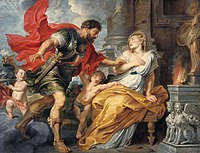Rhea Silvia

Rhea Silvia is a woman from Roman mythology. In the legend about the founding of Rome, is the mother of the twin brothers Romulus and Remus. She was the daughter of Numitor Silvius, king of the city Alba Longa.
According to Plutarch, there are many versions of Rhea Silvia's story, and it is not clear which one is real. But this is one of the best known and most widely accepted: When Numitor's brother Amulius became king by force, he made Rhea Silvia become a Vestal Virgin, so she would not have children who could be kings instead of him. But the god Mars seduced Rhea Silvia and she had the twins Romulus and Remus.[1] For Vestals, the punishment for having sex was death. So when people found out she was pregnant, Rhea Silvia was buried alive, which was the punishment for a Vestal Virgin who did not remain a virgin. Her sons were thrown into the Tiber by a servant, but were saved by the river god Tiberinus, who also saved Rhea Silvia and later married her.
The Tiber River that flows through Rome gets its name from Tiberinus. He married Rhea Silvia while the twins, Romulus and Remus, were raised by a she-wolf. When the babies were a few months old, a cowherd found them and raised them. When they were adults, they decided to build a city together. But they realized only one of them could be its king. The two men waited on opposite hills for an omen while their followers watched. At first, six vultures landed on the hill where Remus was waiting. The followers believed this would mean the city would last for six hundred years. But then twelve vultures landed on Romulus' hill and they named the city after him instead. Shortly afterword, Remus made fun of the city wall Romulus was building. Either one of Romulus' friends or Romulus himself hit Remus, and he died. The city was named after Romulus, Rome.[2]
Related pages
References
- ↑ "Rhea Silvia". University of Dallas. Retrieved January 25, 2020.
- ↑ Plutarch. "Romulus". Translated by John Dryden. Massachusetts Institute of Technology. Retrieved January 25, 2020.